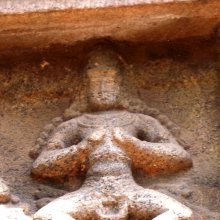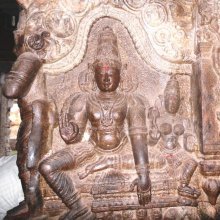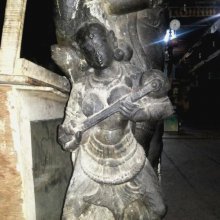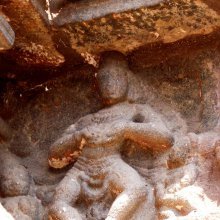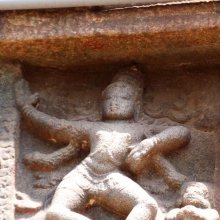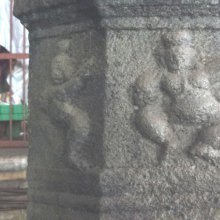Parshva, Pārśva: 29 definitions
Introduction:
Parshva means something in Buddhism, Pali, Hinduism, Sanskrit, Jainism, Prakrit, the history of ancient India, Marathi. If you want to know the exact meaning, history, etymology or English translation of this term then check out the descriptions on this page. Add your comment or reference to a book if you want to contribute to this summary article.
The Sanskrit term Pārśva can be transliterated into English as Parsva or Parshva, using the IAST transliteration scheme (?).
Images (photo gallery)
(+151 more images available)
In Hinduism
Natyashastra (theatrics and dramaturgy)
Source: Wisdom Library: Nāṭya-śāstraPārśva (पार्श्व) refers to the “sides”. It is one of the six major limbs (aṅga) used in dramatic performance, according to the Nāṭyaśāstra chapter 8. With these limbs are made the various gestures (āṅgika), which form a part of the histrionic representation (abhinaya).
These are the five kinds of movements made with the sides (pārśva):
- nata (bent),
- samunnata (raised),
- prasārita (extended),
- vivartita (turned round)
- apasṛta (drawn away).
Pārśva (पार्श्व) refers to the “two sides” representing one of the seven “major limbs” (aṅga), which represents a division of Āṅgikābhinaya (gesture language of the limbs) as used within the classical tradition of Indian dance and performance, also known as Bharatanatyam.—Āṅgika-abhinaya is the gesture language of the limbs. Dance is an art that expresses itself through the medium of body, and therefore, āṅgikābhinaya is essential for any dance and especially for any classical dance of India. Aṅgas or major limbs include the head, hands, chest, sides (viz., Pārśva), waist, and feet; at times the neck is also used as a separate limb.
Pārśva refers to the “movements of the sides”.—In Bharatanatyam, according to Abhinayadarpaṇa, there are no descriptions of the movements of the hip and the waist. However, in Nāṭyaśāstra, there are five movements each of the sides and the hip.
The movements of the sides (pārśva) are:—
- nata (bent),
- samunnata (lifted up),
- prasārita (extended),
- vivartita (turned round),
- apasṛta (withdrawn slightly).

Natyashastra (नाट्यशास्त्र, nāṭyaśāstra) refers to both the ancient Indian tradition (shastra) of performing arts, (natya—theatrics, drama, dance, music), as well as the name of a Sanskrit work dealing with these subjects. It also teaches the rules for composing Dramatic plays (nataka), construction and performance of Theater, and Poetic works (kavya).
Purana and Itihasa (epic history)
Source: JatLand: List of Mahabharata people and placesPārśva (पार्श्व) is a name mentioned in the Mahābhārata (cf. VI.10.54) and represents one of the many proper names used for people and places. Note: The Mahābhārata (mentioning Pārśva) is a Sanskrit epic poem consisting of 100,000 ślokas (metrical verses) and is over 2000 years old.

The Purana (पुराण, purāṇas) refers to Sanskrit literature preserving ancient India’s vast cultural history, including historical legends, religious ceremonies, various arts and sciences. The eighteen mahapuranas total over 400,000 shlokas (metrical couplets) and date to at least several centuries BCE.
Ayurveda (science of life)
Source: gurumukhi.ru: Ayurveda glossary of terms1) Pārśva (पार्श्व):—Sides of the Chest, Flanks
2) [pārśvam] Side of thorax. Side of the part of the body between the base of the neck superiorly and diaphragm inferiorly

Āyurveda (आयुर्वेद, ayurveda) is a branch of Indian science dealing with medicine, herbalism, taxology, anatomy, surgery, alchemy and related topics. Traditional practice of Āyurveda in ancient India dates back to at least the first millenium BC. Literature is commonly written in Sanskrit using various poetic metres.
Kavya (poetry)
Source: OpenEdition books: Vividhatīrthakalpaḥ (Kāvya)Pārśva (पार्श्व) or Pārśvanātha is mentioned in the Vividhatīrthakalpa by Jinaprabhasūri (13th century A.D.): an ancient text devoted to various Jaina holy places (tīrthas).—Accordingly, “Curious when seeing the people carrying flowers, etc., Pārśvanātha goes to the places where the ascetic Kamaṭha (or Kaṭha) practices the asceticism of the five fires. As he is in possession of the threefold knowledge, Pārśva knows that there is a great serpent in the piece of wood which is about to be burned. He notifies the ascetic of this and has the piece of wood split to prove it to him. We see a large snake coming out [...]”.
Cf. Uttarādhyayana: Charpentier in ZDMG 69 335.21-45 (text), 353.6-40 (translation); ŚC (i.e., Śīlāṅka’s Cauppaṇṇamahāpurisacariya ?) 261.24-262.14: Bruhn 1954 p. 95; Triṣaṣṭiśalākāpuruṣacaritra IX 3 v. 212-230; Pārsvanāthacarita (Bhāvadeva) VI v 50-68: Bloomfield 1903 p. 113-114.

Kavya (काव्य, kavya) refers to Sanskrit poetry, a popular ancient Indian tradition of literature. There have been many Sanskrit poets over the ages, hailing from ancient India and beyond. This topic includes mahakavya, or ‘epic poetry’ and natya, or ‘dramatic poetry’.
Jyotisha (astronomy and astrology)
Source: Wisdom Library: Brihat Samhita by VarahamihiraPārśva (पार्श्व) refers to “sides”, according to the Bṛhatsaṃhitā (chapter 4), an encyclopedic Sanskrit work written by Varāhamihira mainly focusing on the science of ancient Indian astronomy astronomy (Jyotiṣa).—Accordingly, “If the two horns of the moon should appear but slightly raised and far from each other presenting the appearance of a boat, she brings trouble on the sailors but prosperity on mankind at large. [...] If, when the northern horn is a little higher than the other and bent aside [i.e., pārśva-śāyin], the southern horn is straight like a carriage pole, pilgrim parties will suffer and there will be no rain. If one of the horns should appear higher than the other and bent down at the end, cows will suffer”.

Jyotisha (ज्योतिष, jyotiṣa or jyotish) refers to ‘astronomy’ or “Vedic astrology” and represents the fifth of the six Vedangas (additional sciences to be studied along with the Vedas). Jyotisha concerns itself with the study and prediction of the movements of celestial bodies, in order to calculate the auspicious time for rituals and ceremonies.
Shaivism (Shaiva philosophy)
Source: Brill: Śaivism and the Tantric TraditionsPārśva (पार्श्व) refers to the “sides”, according to the Guhyasūtra chapter 9.—Accordingly, “[...] [The Lord spoke]:—[...] On one half, there should be a forehead mark; on one half a [forehead] eye. A ring [should be] in one ear; a [pendant] ear-ornament in one ear. He should put a trident in his right hand and a breast on his left side (vāma-pārśva), a girdle on the left half, a bangle on the left arm, a woman’s anklet on the left leg, a man’s anklet on the right leg and a muñja-grass belt. At the hips, he should put a loin-cloth on the right and wear a woman’s garment on the left.”.

Shaiva (शैव, śaiva) or Shaivism (śaivism) represents a tradition of Hinduism worshiping Shiva as the supreme being. Closely related to Shaktism, Shaiva literature includes a range of scriptures, including Tantras, while the root of this tradition may be traced back to the ancient Vedas.
Vastushastra (architecture)
Source: Brill: Śaivism and the Tantric Traditions (architecture)Pārśva (पार्श्व) refers to “one’s side”, according to the Devyāmata (in the section śalyoddhāra-paṭala or “excavation of extraneous substances”).—Accordingly, “[...] If [someone] touches his back, there is [an extraneous thing] arising from the back (pṛṣṭhaja) [, i.e. a back-bone at the depth up to the back]. If [someone touches] his belly, [there is an extraneous thing related to the belly] at the depth up to the [belly]. If [someone] touches his side (pārśva—pārśve saṃsparśanād), one should prognosticate that there is an extraneous thing arising from dust. The best knower of extraneous things [= the officiant] should remove that extraneous thing which exists [at a depth of] that measurement [= up to the side] [underground]. [...]”.
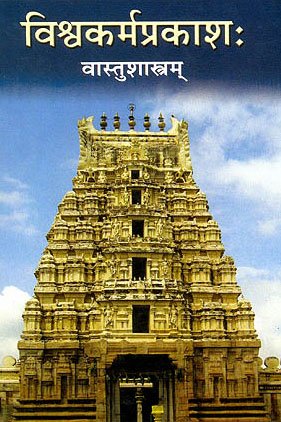
Vastushastra (वास्तुशास्त्र, vāstuśāstra) refers to the ancient Indian science (shastra) of architecture (vastu), dealing with topics such architecture, sculpture, town-building, fort building and various other constructions. Vastu also deals with the philosophy of the architectural relation with the cosmic universe.
In Buddhism
Tibetan Buddhism (Vajrayana or tantric Buddhism)
Source: Wisdom Library: Tibetan BuddhismPārśva (पार्श्व) is the name of a Pratyekabuddha mentioned as attending the teachings in the 6th century Mañjuśrīmūlakalpa: one of the largest Kriyā Tantras devoted to Mañjuśrī (the Bodhisattva of wisdom) representing an encyclopedia of knowledge primarily concerned with ritualistic elements in Buddhism. The teachings in this text originate from Mañjuśrī and were taught to and by Buddha Śākyamuni in the presence of a large audience (including Pārśva).
Source: MDPI Books: The Ocean of HeroesPārśva (पार्श्व) refers to the “side (of a house)”, according to the 10th-century Ḍākārṇava-tantra: one of the last Tibetan Tantric scriptures belonging to the Buddhist Saṃvara tradition consisting of 51 chapters.—Accordingly: “Now, [the Blessed One] has taught [holy sites] such as the pīlava and upapīlava in sequence. [...] The pīlava [sites] are recited to be the border of a village, Kuṅkara (for Koṅkana), Karmāra-pāṭaka (or a district of [many] artisans), and the village where many Yoginīs reside. [Every site is] powerful. (12) Likewise, in this [system], the upapīlava [sites] are an ancestor forest, a side of a house (gṛha-pārśva), a pond, and a lotus pool. Girls who are in these places are of [the nature of] the innate, born in their own birthplaces. [...]”.

Tibetan Buddhism includes schools such as Nyingma, Kadampa, Kagyu and Gelug. Their primary canon of literature is divided in two broad categories: The Kangyur, which consists of Buddha’s words, and the Tengyur, which includes commentaries from various sources. Esotericism and tantra techniques (vajrayāna) are collected indepently.
Mahayana (major branch of Buddhism)
Source: Wisdom Library: Maha Prajnaparamita SastraPārśva (पार्श्व) refers to the “thighs” (of the body), according to Mahāprajñāpāramitāśāstra (chapter 31).—Accordingly, “What is the impurity of the place of birth? Head (śiras), feet (pāda), belly (udara), back (pṛṣṭha), thighs (pārśva), that which is called a woman’s body (strīkāya) is a collection of impure things. Inwardly, it contains a stomach (āmāśaya), a belly (pakvāśaya), excrement (viṣ), urine (mūtra) and [other] impurities (aśuci). Outwardly (bahirdhā), there is a wind (vāta) conditioned by the afflictions (kleśa) and actions (karman), a wind that blows on the seed-consciousness (vijñānabīja) and introduces it within the two viscera. During eight or nine months, the seed-consciousness dwells in a pit of excrement and urine (vinmūtragarta). [...]”.

Mahayana (महायान, mahāyāna) is a major branch of Buddhism focusing on the path of a Bodhisattva (spiritual aspirants/ enlightened beings). Extant literature is vast and primarely composed in the Sanskrit language. There are many sūtras of which some of the earliest are the various Prajñāpāramitā sūtras.
In Jainism
General definition (in Jainism)
Source: Wisdom Library: JainismPārśva (पार्श्व):—The twenty-third Tīrthaṅkara (Janism recognizes 24 such teachers or Siddhas). He is also known by the name Pārśvanātha. His colour is green (harita), according to Aparājitapṛcchā (221.5-7). His height is 9 hatha (4 hatha equals 1 dhanuṣa, which equals 6 feet), thus, roughly corresponding to 4.1 meters. His emblem, or symbol, is a Snake.
Pārśva’s father is Aśvasena and his mother is Vāmā according to Śvetāmbara or Varmilā according to Digambara. It is an ancient Jain practice to worship the Tīrthaṅkara’s parents in various rites, such as the pratiṣṭhāvidhi, according to the Ācāradinakara (14th work on Jain conduct written by Vardhamāna Sūri).
Source: archive.org: The Jaina IconographyPārśva (पार्श्व) (or Vāmana, Dharaṇendra) is the name of the Yakṣa accompanying Pārśvanātha: the twenty-third of twenty-four Tīrthaṃkaras or Jinas, commonly depicted in Jaina iconography.—Pārśvanātha is one of the greatest Tīrthaṃkaras or Prophets of Jainism. [...] From all sources, we gather his emblem or cognizance is a snake. In sculpture, snake seems to be everything with him. Not only do we find snake in the usual place of the symbol, we find, snakes canopy him with three or seven or eleven hoods. His Yakṣa is called Pārśva or Vāmana or Dharaṇendra and Yakṣiṇī is called Padmāvatī. The king, who stands by his side as a Chowri-bearer is known as Ajitarāja. The Devadāru (Deodar) or Dhātaki is his Kevala-tree.
Pārśva Yakṣa of Pārśvanātha is one of the most important amongst the members of his class. His image whether Śvetāmbara or Digambara has the common points of snake-hoods, snake-attribute and a tortoise as vehicle. The Śvetāmbara books, in points of difference, make him appear with four hands holding an ichneumon, snake, citrus and snake (again). The Digambara texts, in turn, give his hands snake, noose and Varada.
Source: archive.org: TrisastisalakapurusacaritraPārśva (पार्श्व) or Pārśvanātha refers to the twenty-third of the twenty-four Tīrthaṅkaras praised in the first book (ādīśvara-caritra) [chapter 1] of Hemacandra’s 11th century Triṣaṣṭiśalākāpuruṣacaritra: an ancient Sanskrit epic poem narrating the history and legends of sixty-three illustrious persons in Jainism.
Pārśva is the son of Vāmā and Aśvasena, according to chapter 1.6, “[...] In Bharata there will be twenty-three other Arhats and eleven other Cakrins. [...] Son of Vāmā and Aśvasena, Pārśva, in Vārāṇasī, dark blue, nine cubits tall, living for a hundred years, will be initiated for seventy years, and the interval will be eighty-three thousand seven hundred and fifty years”.
Source: The University of Sydney: A study of the Twelve ReflectionsParśva (पर्श्व) is the name of an ancient king, according to the 11th century Jñānārṇava, a treatise on Jain Yoga in roughly 2200 Sanskrit verses composed by Śubhacandra.—Accordingly, “Indeed, previously there was King Pārśva (parśvarājaḥ), Śrī Toḍara was the sun for the lotus of his family, Śrī Ṛṣidāsa Sāha, may he live always, was the intense sun [rising from behind] the eastern mountain of his family”.

Jainism is an Indian religion of Dharma whose doctrine revolves around harmlessness (ahimsa) towards every living being. The two major branches (Digambara and Svetambara) of Jainism stimulate self-control (or, shramana, ‘self-reliance’) and spiritual development through a path of peace for the soul to progess to the ultimate goal.
India history and geography
Source: archive.org: Personal and geographical names in the Gupta inscriptionsPārśva (पार्श्व) is an example of a name based on some sect mentioned in the Gupta inscriptions. Various names indicated Buddhist or Jain sects. The Gupta empire (r. 3rd-century CE), founded by Śrī Gupta, covered much of ancient India and embraced the Dharmic religions such as Hinduism, Buddhism and Jainism. Derivation of personal names (e.g., Pārśva) during the rule of the Guptas followed patterns such as tribes, places, rivers and mountains.
Source: Cologne Digital Sanskrit Dictionaries: Indian Epigraphical GlossaryPārśva.—(HRS), extra charge upon land over and above the king's grain-share, which was a branch of ‘accidental re- venue’ according to the Arthaśāstra. See Ghoshal, H. Rev. Syst., pp. 28, 38. (IE 8-4), explained by some as a small territorial unit; but may be ‘side’; cf. prāveśya. Note: pārśva is defined in the “Indian epigraphical glossary” as it can be found on ancient inscriptions commonly written in Sanskrit, Prakrit or Dravidian languages.

The history of India traces the identification of countries, villages, towns and other regions of India, as well as mythology, zoology, royal dynasties, rulers, tribes, local festivities and traditions and regional languages. Ancient India enjoyed religious freedom and encourages the path of Dharma, a concept common to Buddhism, Hinduism, and Jainism.
Languages of India and abroad
Marathi-English dictionary
Source: DDSA: The Molesworth Marathi and English Dictionarypārśva (पार्श्व) [or पार्श्विक, pārśvika].—a S Relating to a side of the body, lateral.
Marathi is an Indo-European language having over 70 million native speakers people in (predominantly) Maharashtra India. Marathi, like many other Indo-Aryan languages, evolved from early forms of Prakrit, which itself is a subset of Sanskrit, one of the most ancient languages of the world.
Sanskrit dictionary
Source: DDSA: The practical Sanskrit-English dictionaryPārśva (पार्श्व).—a. Near, proximate.
-rśvaḥ, -rśvam [parśūnāṃ samūhaḥ]
1) The part of the body below the arm-pit, the region of the ribs; वामं पार्श्वं विनिर्भिद्य सुतः सूर्य इव स्थितः (vāmaṃ pārśvaṃ vinirbhidya sutaḥ sūrya iva sthitaḥ) Mahābhārata (Bombay) 3. 126.27; शयने सन्निषण्णैकपार्श्वाम् (śayane sanniṣaṇṇaikapārśvām) Meghadūta 91.
2) The side, flank (in general) (of animate or inanimate objects), पिठरं क्वथदतिमात्रं निजपार्श्वानेव दहतितराम् (piṭharaṃ kvathadatimātraṃ nijapārśvāneva dahatitarām) Pañcatantra (Bombay) 1.324.
3) Vicinity.
4) Ved. A curved knife.
-rśvaḥ An epithet of the twentythird Tīrthaṅkar of the Jainas.
-rśvam 1 A multitude of ribs.
2) A fraudulent expedient, a dishonourable means.
3) The extremity of the fore-axle of a wheel. (pārśvam is used adverbially in the sense of 'near to', 'by the side of', 'towards'; kenāpyutkṣipateva paśya bhuvanaṃ matpārśvamānīyate Ś.7.8; so pārśvāt 'from the side of, away, from'; pārśve 'near', 'at hand', 'at the side'; name dūre kiṃcit kṣaṇamapi na pārśve rathajavāt Ś.1.9; Bhartṛhari 3.37.)
Source: Cologne Digital Sanskrit Dictionaries: Edgerton Buddhist Hybrid Sanskrit DictionaryPārśva (पार्श्व).—(m., nt. ?), lying or leaning on one's side, leaning, slouching: in composition with -sukham, (divaṃ nidrā- sukhaṃ) pārśvasukhaṃ śayanasukhaṃ ca svīkurvataḥ Bodhisattvabhūmi 156.18, of one who is attached to the pleasures of sleeping by day or lying (leaning) on his side or (keeping to) his bed; (nidrāsukhaṃ śayanasukhaṃ) pārśvasukhaṃ ca Bodhisattvabhūmi 172.2; as object of verb of giving, (na tv akāle) pārśvam anu- prayacchati mañce vā pīṭhe vā tṛṇasaṃstare vā…Bodhisattvabhūmi 193.(19—)20, but he does not lie down (? lean, slouch; lit. give a side) at improper times on a couch or stool or grass- bed; na jātu pārśvaṃ dattavān, na styāna-middham (q.v.) avakrāmitavān Rāṣṭrapālaparipṛcchā 57.10, he did not at all ‘give a side’, nor give way to sloth and torpor; in Mūla-Sarvāstivāda-Vinaya i.237.7—8, 11 seems to mean leans, lounges, slouches: (bhikṣavaḥ) pār- śvaṃ dattvā tiṣṭhanti…kimarthaṃ pārśvaṃ dattvā tiṣṭhatha?…kṣudhārtā durbalā jātāḥ, ataḥ (11) pārśvaṃ dattvā sthitāḥ; possibly, however, it may mean stays (at home) lying down.
Source: Cologne Digital Sanskrit Dictionaries: Shabda-Sagara Sanskrit-English DictionaryPārśva (पार्श्व).—mfn.
(-rśvaḥ-rśvā-rśvaṃ) Near, proximate, by the side of. mn.
(-rśvaḥ-rśvaṃ) 1. A side, the part of the body below the armpit. 2. The curve or circumference of a wheel. 3. Side of any square figure. n.
(-rśvaṃ) 1. A multitude of ribs, the thorax. 2. A fraudulent or crooked expedient. m.
(-rśvaḥ) The twenty-third Jina or Jaina pontiff. E. spṛś to touch, śvaṇ Unadi aff., and pṛ substituted for the root; or parśu a rib, aff. aṇ.
Source: Cologne Digital Sanskrit Dictionaries: Benfey Sanskrit-English DictionaryPārśva (पार्श्व).—i. e. parśu (ved. a rib), + a, n. and m. 1. The part of the body below the armpit. 2. A side, Mahābhārata 13, 2749. 3. = pārṣṇi 3, q. cf. 4. Proximity. 5. ve, loc. Near, [Śākuntala, (ed. Böhtlingk.)] [distich] 9. 6. vam, acc. Near to, [Rājataraṅgiṇī] 5, 467.
Source: Cologne Digital Sanskrit Dictionaries: Cappeller Sanskrit-English DictionaryPārśva (पार्श्व).—[neuter] ([masculine]) the region of the ribs, [plural] the ribs; flank, side, immediate neighbour-hood. Acc. near to, towards, [locative] close to, near; [ablative] away from, on the part or by means of.
Source: Cologne Digital Sanskrit Dictionaries: Monier-Williams Sanskrit-English Dictionary1) Pārśva (पार्श्व):—[from pārśava] a n. (rarely m. [gana] ardharcādi; ifc. f(ā). [from] 1. parśu) the region of the ribs ([plural] the ribs), side, flank (either of animate or inanimate objects), [Ṛg-veda] etc. etc.
2) [v.s. ...] the side = nearness, proximity (with [genitive case] or ifc.; ayaḥ, on both sides; am, aside, towards; e, at the side, near opp. to dura-tas; āt, away, from; by means of, through), [Mahābhārata; Kāvya literature] etc.
3) [v.s. ...] a curved knife, [Śatapatha-brāhmaṇa]
4) [v.s. ...] a side of any square figure, [Horace H. Wilson]
5) [v.s. ...] the curve or circumference of a wheel, [ib.]
6) [v.s. ...] (only) a multitude of ribs, the thorax, [Horace H. Wilson]
7) [v.s. ...] the extremity of the fore-axle nearest the wheel to which the outside horses of a four-horse chariot are attached, [cf. Lexicographers, esp. such as amarasiṃha, halāyudha, hemacandra, etc.]
8) [v.s. ...] a fraudulent or crooked expedient, [cf. Lexicographers, esp. such as amarasiṃha, halāyudha, hemacandra, etc.]
9) [v.s. ...] m. the side horse on a chariot, [Mahābhārata]
10) [v.s. ...] Name of an ancient Buddhist teacher
11) [v.s. ...] (with Jainas) Name of the 23rd Arhat of the present Ava-sarpiṇī and of his servant
12) [v.s. ...] ([dual number]) heaven and earth, [cf. Lexicographers, esp. such as amarasiṃha, halāyudha, hemacandra, etc.]
13) [v.s. ...] mfn. near, proximate (cf. [compound] below).
14) b See [column]1.
Source: Cologne Digital Sanskrit Dictionaries: Yates Sanskrit-English DictionaryPārśva (पार्श्व):—[(rśvaḥ-rśvaṃ)] 1. m. n. A side; curve of a wheel; many ribs; crooked expedient. m. 23rd Jaina pontiff. a. Near, by the side of.
Source: DDSA: Paia-sadda-mahannavo; a comprehensive Prakrit Hindi dictionary (S)Pārśva (पार्श्व) in the Sanskrit language is related to the Prakrit words: Pāsa, Pāsalla.
[Sanskrit to German]
Sanskrit, also spelled संस्कृतम् (saṃskṛtam), is an ancient language of India commonly seen as the grandmother of the Indo-European language family (even English!). Closely allied with Prakrit and Pali, Sanskrit is more exhaustive in both grammar and terms and has the most extensive collection of literature in the world, greatly surpassing its sister-languages Greek and Latin.
Kannada-English dictionary
Source: Alar: Kannada-English corpusPārśva (ಪಾರ್ಶ್ವ):—
1) [noun] the region either to the left or right of a person, thing, etc.
2) [noun] the region of the ribs in humans or any other animals; flank.
3) [noun] proximity; nearness.
4) [noun] a fradulent or crooked expedient.
5) [noun] the outer face of any of the outer faces of a solid object; surface.
6) [noun] the outer, circular part of a wheel; a rim.
7) [noun] (jain.) the twenty third tīrthaṃkara, the jaina spiritual teacher.
Kannada is a Dravidian language (as opposed to the Indo-European language family) mainly spoken in the southwestern region of India.
See also (Relevant definitions)
Starts with (+110): Parshva-lekhana, Parshvabakasana, Parshvabhaga, Parshvabhagini, Parshvabhanga, Parshvabhimukha, Parshvacandra, Parshvacandrasuri, Parshvacanta, Parshvacara, Parshvaccheda, Parshvachanta, Parshvachara, Parshvachchheda, Parshvacitra, Parshvada, Parshvadaha, Parshvadamdapada, Parshvadanda, Parshvadesha.
Ends with (+9): Ajaparshva, Antahparshva, Anuparshva, Anyatparshva, Atiparshva, Bhagnaparshva, Brahmaparshva, Catushparshva, Chatushparshva, Dashaparshva, Gaudaparshva, Gayatraparshva, Grihaparshva, Himpashrva, Mahaparshva, Pariparshva, Parshvopaparshva, Prishthaparshva, Samyamaparshva, Suparshva.
Full-text (+267): Parshvanatha, Parshvashula, Parshvasthi, Parshvabhaga, Anuparshva, Parshvagata, Pasha, Parshvada, Parshvashaya, Pariparshvika, Parshvaruj, Parshvasthita, Parshvapippala, Parshvagamana, Parshvadesha, Parshvaparivartin, Parshvavivartin, Parshvaga, Parshvatas, Parshvasina.
Relevant text
Search found 48 books and stories containing Parshva, Pārśva, Parsva, Pārśvā; (plurals include: Parshvas, Pārśvas, Parsvas, Pārśvās). You can also click to the full overview containing English textual excerpts. Below are direct links for the most relevant articles:
Garga Samhita (English) (by Danavir Goswami)
Verse 6.17.24 < [Chapter 17 - Śrī Śrī Rādhā and Kṛṣṇa Meet at Siddhāśrama and the Nature of Śrī Rādhā’s Love Is Revealed]
Verse 3.2.11 < [Chapter 2 - The Great Festival of Śrī Girirāja]
Verse 5.9.12 < [Chapter 9 - The Happiness of the Yadus]
Kalpa-sutra (Lives of the Jinas) (by Hermann Jacobi)
Brihad Bhagavatamrita (commentary) (by Śrī Śrīmad Bhaktivedānta Nārāyana Gosvāmī Mahārāja)
Verse 2.2.135 < [Chapter 2 - Jñāna (knowledge)]
Verse 1.4.71 < [Chapter 4 - Bhakta (the devotee)]
Verse 1.7.69 < [Chapter 7 - Pūrṇa (pinnacle of excellent devotees)]
Trishashti Shalaka Purusha Caritra (by Helen M. Johnson)
Part 8: Pārśva’s initiation < [Chapter III - Birth, youth, initiation, and omniscience of Śrī Pārśva]
Part 7: Defense of Prasenajit < [Chapter III - Birth, youth, initiation, and omniscience of Śrī Pārśva]
Part 5: Pārśva’s childhood < [Chapter III - Birth, youth, initiation, and omniscience of Śrī Pārśva]
Bhakti-rasamrta-sindhu (by Śrīla Rūpa Gosvāmī)
Verse 3.3.34 < [Part 3 - Fraternal Devotion (sakhya-rasa)]
Verse 2.1.337 < [Part 1 - Ecstatic Excitants (vibhāva)]
Verse 2.1.185 < [Part 1 - Ecstatic Excitants (vibhāva)]
Jainism in Odisha (Orissa) (by Ashis Ranjan Sahoo)
Narrative Panels in Odisha < [Chapter 5]
Iconography of Jain Gods and Goddess < [Chapter 6]
Iconography of Tirthankaras < [Chapter 6]
